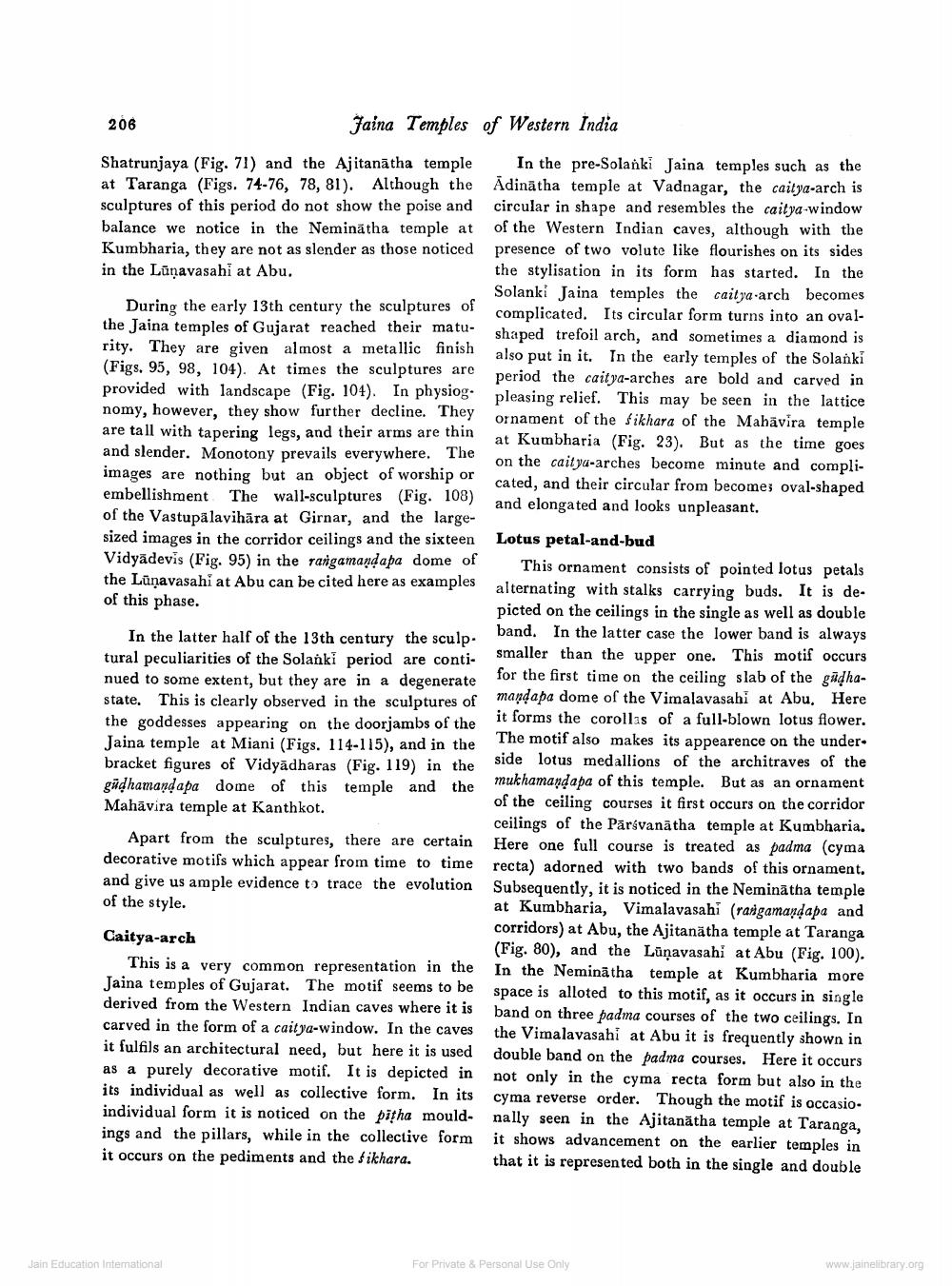________________
206
Jaina Temples of Western India
Shatrunjaya (Fig. 71) and the Ajitanātha temple In the pre-Solanki Jaina temples such as the at Taranga (Figs. 74-76, 78, 81). Although the Adinātha temple at Vadnagar, the caitya-arch is sculptures of this period do not show the poise and circular in shape and resembles the caitya-window balance we notice in the Neminātha temple at of the Western Indian caves, although with the Kumbharia, they are not as slender as those noticed presence of two volute like flourishes on its sides in the Lūnavasahi at Abu.
the stylisation in its form has started. In the
Solanki Jaina temples the caitya-arch becomes During the early 13th century the sculptures of
complicated. Its circular form turns into an ovalthe Taina temples of Gujarat reached their matu- shaped trefoil arch, and sometimes a diamond is rity. They are given almost a metallic finish also put in it. In the early temples of the Solanki (Figs. 95, 98, 104). At times the sculptures are
period the caitya-arches are bold and carved in provided with landscape (Fig. 104). In physiog. pleasing relief. This may be seen in the lattice nomy, however, they show further decline. They
ornament of the Sikhara of the Mahävira temple are tall with tapering legs, and their arms are thin
at Kumbharia (Fig. 23). But as the time goes and slender. Monotony prevails everywhere. The on the caityu-arches become minute and compliimages are nothing but an object of worship or cated, and their circular from becomes oval-shaped embellishment The wall-sculptures (Fig. 108)
and elongated and looks unpleasant. of the Vastupālavihāra at Girnar, and the largesized images in the corridor ceilings and the sixteen Lotus petal-and-bud
evis (Fig. 95) in the rangamandapa dome of This ornament consists of pointed lotus petals the Länavasahi at Abu can be cited here as examples alternating with stalks carrying buds. It is de. of this phase.
picted on the ceilings in the single as well as double In the latter half of the 13th century the sculp.
band. In the latter case the lower band is always
smaller than the upper one. This motif occurs tural peculiarities of the Solanki period are conti
for the first time on the ceiling slab of the gadhanued to some extent, but they are in a degenerate state. This is clearly observed in the sculptures of mandapa dome of the Vimalavasahi at Abu, Here the goddesses appearing on the doorjambs of the
it forms the corollas of a full-blown lotus flower.
The motif also makes its appearence on the under. Jaina temple at Miani (Figs. 114-115), and in the bracket figures of Vidyadharas (Fig. 119) in the
side lotus medallions of the architraves of the
mukhamandapa of this temple. But as an ornament gūdhamandapa dome of this temple and the
of the ceiling courses it first occurs on the corridor Mahavira temple at Kanthkot.
ceilings of the Pārsvanātha temple at Kumbharia. Apart from the sculptures, there are certain Here one full course is treated as padma (cyma decorative motifs which appear from time to time recta) adorned with two bands of this ornament. and give us ample evidence to trace the evolution Subsequently, it is noticed in the Neminātha temple of the style.
at Kumbharia, Vimalavasahi (rangamandapa and
corridors) at Abu, the Ajitanātha temple at Taranga Caitya-arch
(Fig. 80), and the Lūņavasahi at Abu (Fig. 100). This is a very common representation in the In the Neminātha temple at Kumbharia more Jaina temples of Gujarat. The motif seems to be space is alloted to this motif, as it occurs in single derived from the Western Indian caves where it is band on three padma courses of the two ceilings. In carved in the form of a caitya-window. In the caves the Vimalavasahi at Abu it is frequently shown in it fulfils an architectural need, but here it is used double band on the padma courses. Here it occurs as a purely decorative motif. It is depicted in not only in the cyma recta form but also in the its individual as well as collective form. In its cyma reverse order. Though the motif is occasioindividual form it is noticed on the pitha mould- nally seen in the Ajitanātha temple at Taranga, ings and the pillars, while in the collective form it shows advancement on the earlier temples in it occurs on the pediments and the Sikhara.
that it is represented both in the single and double
www.jainelibrary.org
Jain Education Intemational
For Private & Personal Use Only




